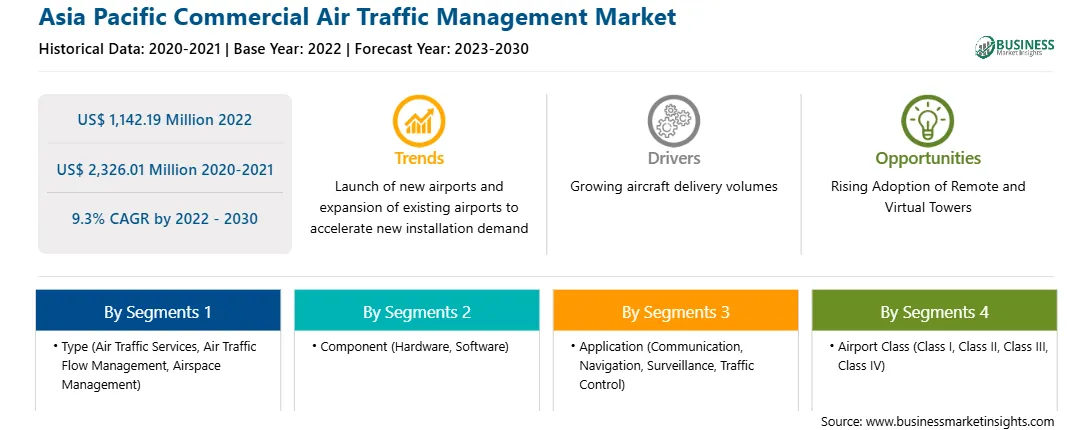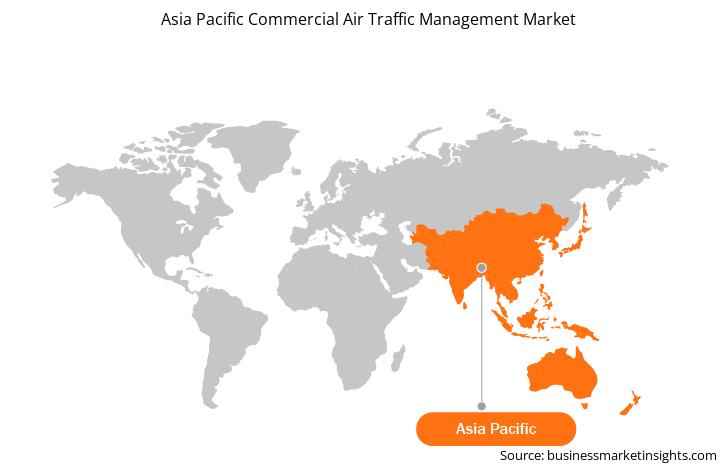Asia Pacific Commercial Air Traffic Management Market
No. of Pages: 229 | Report Code: BMIRE00026163 | Category: Technology, Media and Telecommunications
No. of Pages: 229 | Report Code: BMIRE00026163 | Category: Technology, Media and Telecommunications
The growing demand for air transport worldwide compels the government to invest in more reliable and accurate management systems. Various countries are investing in technologies for safe and efficient air transport. In July 2022, the Chinese government announced an investment of around US$ 100 million for the expansion of São Tomé International Airport. The project will enhance the airport’s capability of managing air traffic movements in the coming years by integrating newer technologies. The government focuses on repairing and replacing hundreds of buildings and pieces of equipment to enhance flight operations. Thus, for the safer flights and efficient air transport, governments of various countries are investing in ATCs to create lucrative market growth opportunities in the Asia Pacific commercial air traffic management market.
Asia Pacific Commercial Air Traffic Management Market Overview
The Asia Pacific commercial air traffic management market is segmented into Australia, China, India, Japan, South Korea, and the Rest of APAC. Asia Pacific has the fastest-growing aviation industry that comprises the development of many airports and procurement pipelines of a large volume of commercial aircraft to cater to the continuously growing passenger traffic across different countries of the region. Moreover, the growing interest of FDI companies to invest in developing economies, such as India and Southeast Asian countries, to develop a strong aviation hub across the region is driving the market.
The rising demand for air travel across highly populated countries such as China and India, owing to the rising purchasing power of customers, is leading to an increase in passenger traffic across the region. This is further leading to the higher procurement of new aircraft across the region. For instance, in 2022, DGCA of India already announced plans to construct ~80 airports by the end of 2027, which is expected to catalyze the deployment of air traffic management systems during the forecast period. Similarly, in 2020, the Civil Aviation Administration of China (CAAC) announced to increase the number of civil airports from 241 to ~400 by the end of 2035, which means that China is expected to construct ten airports every year between 2021 and 2035. Such developments are likely to catalyze the Asia Pacific commercial air traffic management market growth during the forecast period.
Strategic insights for the Asia Pacific Commercial Air Traffic Management provides data-driven analysis of the industry landscape, including current trends, key players, and regional nuances. These insights offer actionable recommendations, enabling readers to differentiate themselves from competitors by identifying untapped segments or developing unique value propositions. Leveraging data analytics, these insights help industry players anticipate the market shifts, whether investors, manufacturers, or other stakeholders. A future-oriented perspective is essential, helping stakeholders anticipate market shifts and position themselves for long-term success in this dynamic region. Ultimately, effective strategic insights empower readers to make informed decisions that drive profitability and achieve their business objectives within the market.

| Report Attribute | Details |
|---|---|
| Market size in 2022 | US$ 1,142.19 Million |
| Market Size by 2030 | US$ 2,326.01 Million |
| Global CAGR (2022 - 2030) | 9.3% |
| Historical Data | 2020-2021 |
| Forecast period | 2023-2030 |
| Segments Covered |
By Type
|
| Regions and Countries Covered | Asia-Pacific
|
| Market leaders and key company profiles |
The geographic scope of the Asia Pacific Commercial Air Traffic Management refers to the specific areas in which a business operates and competes. Understanding local distinctions, such as diverse consumer preferences (e.g., demand for specific plug types or battery backup durations), varying economic conditions, and regulatory environments, is crucial for tailoring strategies to specific markets. Businesses can expand their reach by identifying underserved areas or adapting their offerings to meet local demands. A clear market focus allows for more effective resource allocation, targeted marketing campaigns, and better positioning against local competitors, ultimately driving growth in those targeted areas.

Asia Pacific Commercial air traffic management Market Segmentation
The Asia Pacific commercial air traffic management market is segmented into type, component, application, airport class, and country.
Based on type, the Asia Pacific commercial air traffic management market is segmented into air traffic services, air traffic flow management, and airspace management. The airspace management segment accounted for the largest share in the market in 2022.
Based on component, the Asia Pacific commercial air traffic management market is segmented into hardware and software. The hardware segment accounted for the larger share in the market in 2022.
Based on application, the Asia Pacific commercial air traffic management market is segmented into communication, navigation, surveillance, traffic control, and others. The surveillance segment accounted for the largest share in the market in 2022.
Based on airport class, the Asia Pacific commercial air traffic management market is segmented into Class I, Class II, Class III, and Class IV. The Class I segment accounted for the largest share in the market in 2022.
Based on country, the Asia Pacific commercial air traffic management market is segmented into Australia, China, India, Japan, South Korea, and the Rest of Asia Pacific. China dominated the market share in 2022.
BAE Systems Plc, Honeywell International Inc, Indra Sistemas SA, L3Harris Technologies Inc, Leonardo SpA, NEC Corp, Raytheon Technologies Corp, Saab AB, SITA SC, and Thales SA are the leading companies operating in the Asia Pacific commercial air traffic management market.
The Asia Pacific Commercial Air Traffic Management Market is valued at US$ 1,142.19 Million in 2022, it is projected to reach US$ 2,326.01 Million by 2030.
As per our report Asia Pacific Commercial Air Traffic Management Market, the market size is valued at US$ 1,142.19 Million in 2022, projecting it to reach US$ 2,326.01 Million by 2030. This translates to a CAGR of approximately 9.3% during the forecast period.
The Asia Pacific Commercial Air Traffic Management Market report typically cover these key segments-
The historic period, base year, and forecast period can vary slightly depending on the specific market research report. However, for the Asia Pacific Commercial Air Traffic Management Market report:
The Asia Pacific Commercial Air Traffic Management Market is populated by several key players, each contributing to its growth and innovation. Some of the major players include:
The Asia Pacific Commercial Air Traffic Management Market report is valuable for diverse stakeholders, including:
Essentially, anyone involved in or considering involvement in the Asia Pacific Commercial Air Traffic Management Market value chain can benefit from the information contained in a comprehensive market report.